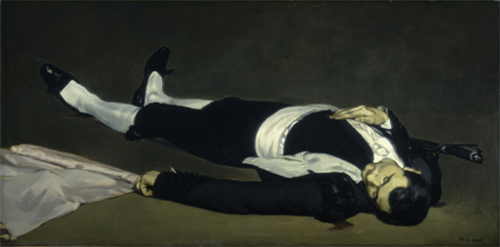September 25, 2010 - March 20, 2011
 |
| Édouard Manet, The Dead Toreador, 1864, oil on canvas, Courtesy National Gallery of Art, Washington, D.C. |
About the Exhibition
In September, one of our French masterpieces, The Brooding Woman, will travel to the Tate Modern in London and then on to the National Gallery in Washington, D.C. for the exhibition, Paul Gauguin: Maker of Myth. As this important work is a cornerstone of our European Painting collection, the National Gallery has generously agreed to loan to WAM one of its French masterpieces, Édouard Manet's The Dead Toreador. This is a thrilling opportunity for all of us to learn about one of art history's greatest masters, as well as to take a closer look at our rich holdings in Spanish and French art.
About the Artist and the Painting
Revered by his contemporaries as the father of modern art, Édouard Manet produced work with a connoisseurs' eye toward Old Master painting as well as an unprecedented sensitivity to the new Paris emerging around him. Maligned by contemporary critics for a lack of refinement, even grotesquery in his painting, Manet was uncompromising and confrontational in both subject matter and style. Today his gestural, confident brushstroke, his exaggerated chiaroscuro, and his flat, shallow figures are considered foundational to abstract art. Further, Manet spearheaded the shift toward painting modem narratives as opposed to the more traditional genres of history or religious painting.
The 1850s and 60s saw a complete overhaul of the Parisian landscape. Napoleon III, under the direction of Baron Georges Haussmann, gutted the heart of Paris to build an expansive monumental metropolis. Manet embraced the urban milieu of consumerism and industry that arose around him.
At the same time, Manet was often seen painting copies of Spanish masters like Velázquez, Zurbarán, EI Greco, Murillo, and later Goya. The avant-garde art critic and poet Charles Baudelaire wrote that with Manet, “the genius of Spain seems to have taken refuge in France.” Manet was attracted to the “cleanliness” of Spanish painting, notably the employment of an Italian stylistic device, tenebrism, which utilizes a stark juxtaposition of light and dark values.
The Dead Toreador, considered a masterpiece of French painting, was originally part of a larger work called Incident at a Bullfight, displayed in the Salon of 1864. The painting was eviscerated by the critics. One critic said that Manet had decided to give up paints in favor of filling his canvases with ink. Likely due to the relentless criticism and caricatures of the painting, Manet cut the work into two parts resulting in The Dead Toreador from the National Gallery of Art in Washington D.C., and The Bullfight, now hanging in the Frick Museum in New York.
The figure in The Dead Toreador showcases Manet's appreciation for the theatricality of Velázquez's figures, emphasized by the extreme foreshortening and reduction of the picture plane. The subject of the work, a gored bullfighter, looks more like a model on a studio floor than a bullfighter in a ring; however, the shallow and non-descript background unabashedly thrusts the dead figure into the viewer's space. Provocative in its use of high contrast color and flattened surface, The Dead Toreador is a distinctly modern warrior, emblematic of a tragic final performance for the bourgeois spectator.

 Sign up for WAM eNews
Sign up for WAM eNews